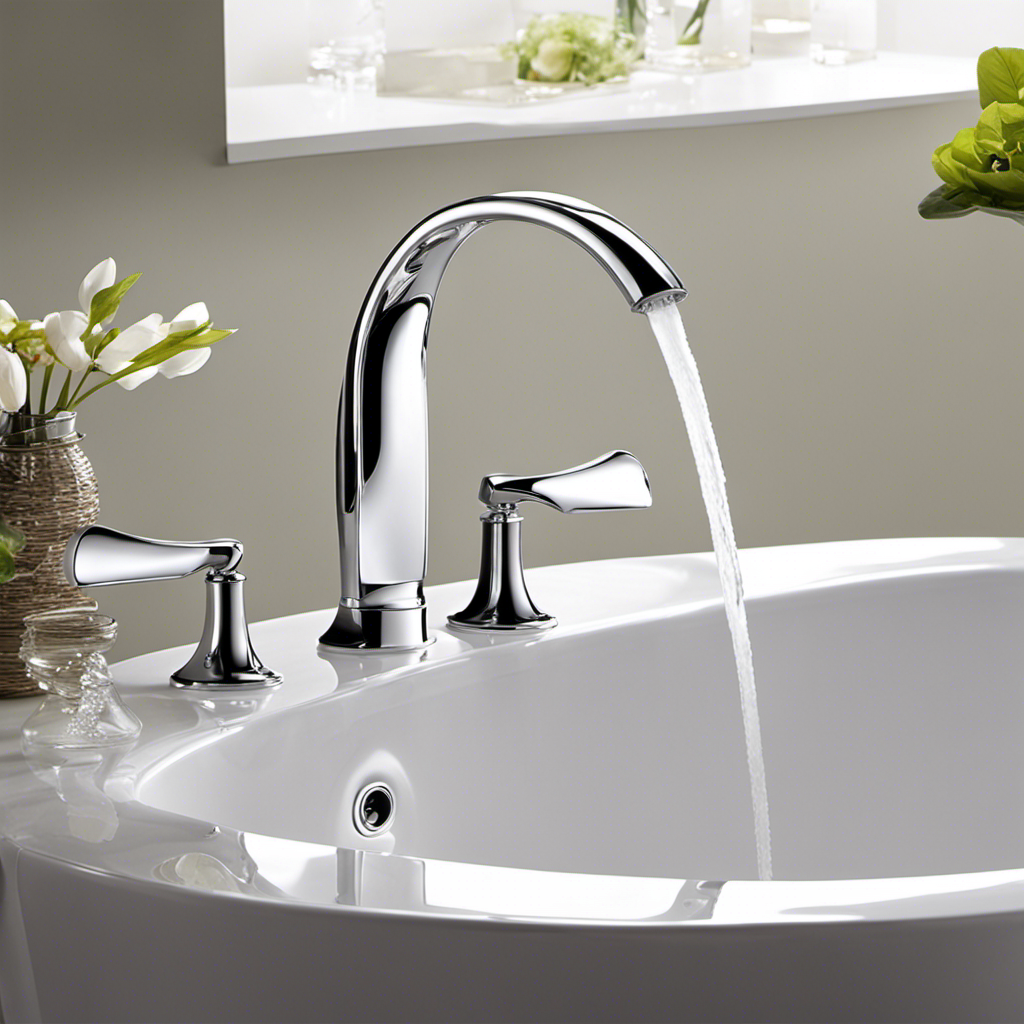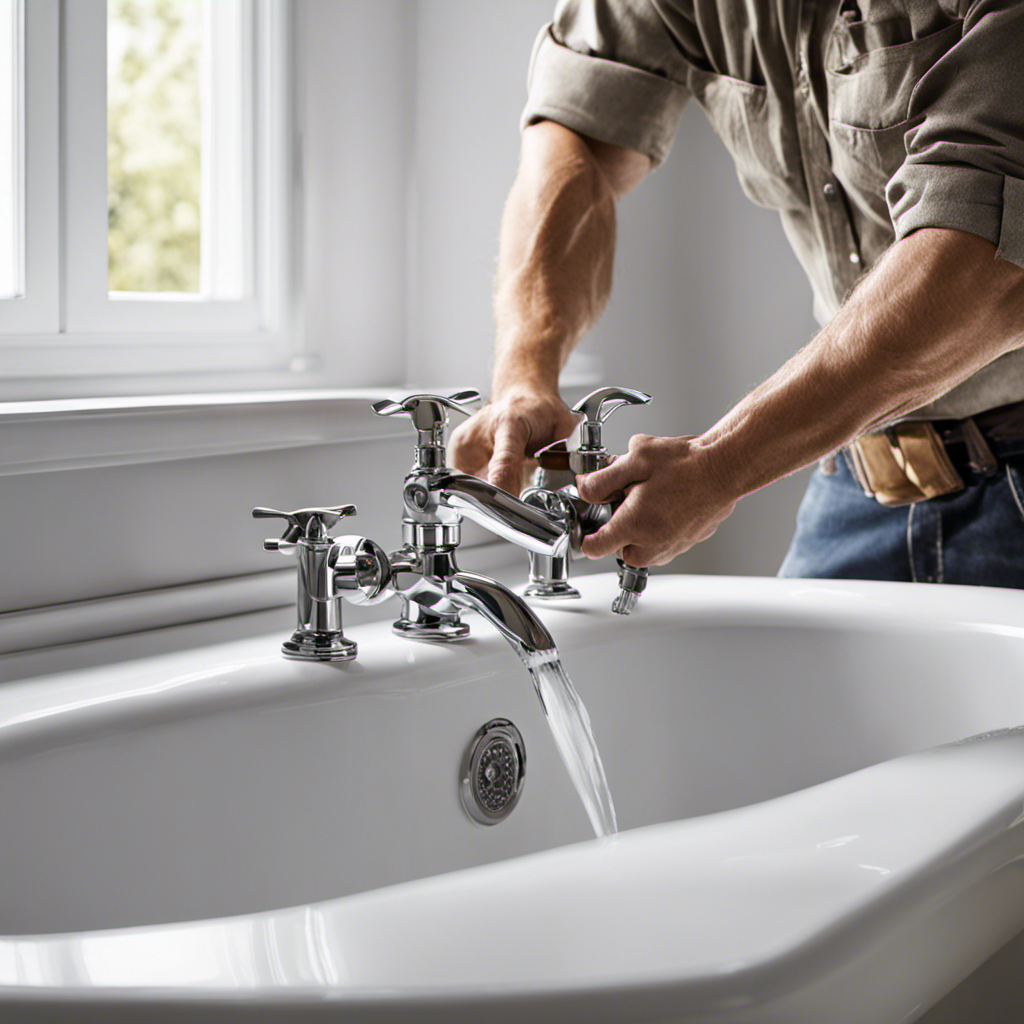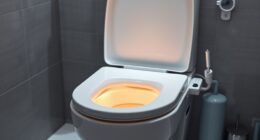You might be wondering, ‘What’s the big deal about a drop in bathtub?’ Well, let me tell you, there are plenty of benefits to having one in your bathroom.
From the different types available to how to install them, I’ll cover everything you need to know.
Plus, I’ll share some design ideas and maintenance tips to keep your drop in bathtub looking and functioning at its best.
So, let’s dive in and explore the world of drop in bathtubs together.
Key Takeaways
- Drop-in bathtubs offer flexibility, easy installation, and a seamless look.
- They can be customized in terms of materials, shapes, and sizes.
- Size considerations include length, width, depth, and surrounding space.
- Factors to consider when choosing a drop-in bathtub include accessibility features, cost, maintenance costs, bathroom size and layout, and style/design.
Benefits of a Drop in Bathtub
If you’re looking for a bathtub that offers flexibility and easy installation, you’ll love the benefits of a drop in bathtub.
Drop in bathtubs are a popular choice for many homeowners due to their versatility and functionality. Unlike freestanding bathtubs, drop in bathtubs are designed to be installed into an existing structure, such as a platform or alcove, creating a seamless and integrated look.
One of the main advantages of a drop in bathtub is its customizability. You can choose from a variety of materials, shapes, and sizes to suit your specific needs and preferences. Additionally, drop in bathtubs are known for their durability and ease of maintenance.
However, it’s important to consider the cons as well. Drop in bathtubs require professional installation and can be more expensive than freestanding bathtubs. They also lack the flexibility of mobility that a freestanding bathtub offers.
Despite these drawbacks, drop in bathtubs remain a popular choice for those seeking a versatile and stylish bathing option.
Now, let’s explore the different types of drop in bathtubs.
Different Types of Drop in Bathtubs
When it comes to drop-in bathtubs, there are a few important factors to consider.
First, the material options for drop-in bathtubs vary, with choices ranging from acrylic to cast iron.
Second, size considerations are crucial to ensure the bathtub fits properly in the designated space.
Lastly, understanding the different installation methods for drop-in bathtubs is essential for a successful and seamless installation process.
Material Options for Drop-In Bathtubs
For your drop-in bathtub, you can choose from a variety of materials including acrylic, fiberglass, or porcelain. Each material has its own pros and cons, so it’s important to consider your specific needs and preferences before making a decision.
Here are the key characteristics of each material:
-
Acrylic: This material is lightweight, durable, and easy to clean. It also retains heat well, providing a comfortable bathing experience. However, acrylic can scratch easily and may fade over time.
-
Fiberglass: Fiberglass is another lightweight option that is resistant to staining and fading. It is also affordable and easy to install. However, it is not as durable as other materials and may crack or chip with heavy use.
-
Porcelain: Porcelain is a classic and elegant choice for a drop-in bathtub. It is extremely durable and resistant to scratches and stains. However, it is heavier and more expensive than other materials, and may require additional support during installation.
Consider these factors when choosing the material for your drop-in bathtub to ensure you make the best decision for your needs.
Size Considerations for Drop-In Bathtubs
To ensure a comfortable bathing experience, you should consider the size of the space where you plan to install your drop-in tub. The size of the bathtub will depend on the available space in your bathroom and your personal preferences. Here are some important space considerations to keep in mind:
| Space Consideration | Measurement |
|---|---|
| Length | 5-7 feet |
| Width | 2.5-3.5 feet |
| Depth | 1.5-2 feet |
| Clearance | 2-3 feet |
| Surrounding Space | 2-3 feet |
The length and width of the bathtub determine how much space you have to stretch out and move around comfortably. The depth of the tub affects how much water you can fill and how submerged you can be. Additionally, you need to consider the clearance around the tub for easy access and cleaning. Taking these measurements into account will help you choose the right size drop-in tub for your bathroom. Now that you understand the size considerations, let’s explore the installation methods for drop-in bathtubs.
Installation Methods for Drop-In Bathtubs
The installation methods for drop-in tubs vary depending on the specific design and features of each model. Here are four key steps to consider when installing a drop-in bathtub:
-
Preparation: Ensure that the bathroom floor is level and sturdy enough to support the weight of the tub. Measure and mark the installation area.
-
Rough-in: Connect the drain and water supply lines to the appropriate plumbing fixtures. Install any necessary framing or supports for the bathtub.
-
Placement: Carefully lower the drop-in tub into the designated area, aligning it with the plumbing fixtures. Level the tub and secure it in place using screws or brackets.
-
Finishing touches: Seal the edges of the bathtub with caulk to prevent water leakage. Install the necessary accessories, such as faucets and handles, according to the manufacturer’s instructions.
How to Install a Drop in Bathtub
When installing a drop-in bathtub, you’ll need to ensure that the frame is level and secure before placing the tub into position. To begin, gather all necessary tools and materials, including a level, screws, and a drill.
Start by measuring and marking the desired location for the tub. Next, build a sturdy frame using pressure-treated lumber, making sure it is level and securely attached to the surrounding walls. Once the frame is in place, carefully lower the tub into position, ensuring it fits snugly and aligns with the drain and water supply lines.
Secure the tub to the frame using screws, following the manufacturer’s instructions. Finally, seal the gaps between the tub and the frame with waterproof caulk, and allow it to dry completely before using the bathtub.
Now that you know how to install a drop-in bathtub, let’s explore some factors to consider when choosing the perfect one for your bathroom.
Factors to Consider When Choosing a Drop in Bathtub
If you’re looking for a new tub, you’ll want to think about the size and style that will best suit your bathroom. Here are some factors to consider when choosing a drop-in bathtub:
-
Accessibility features: If you have mobility issues or plan to age in place, consider a bathtub with accessibility features such as grab bars or built-in seating.
-
Cost considerations: Drop-in bathtubs come in a range of prices, so it’s important to set a budget and consider the long-term costs of maintenance and repairs.
-
Size and layout: Measure your bathroom space and consider the layout to determine the right size and shape of the drop-in bathtub.
-
Style and design: Choose a drop-in bathtub that matches the overall aesthetic of your bathroom, whether it’s modern, traditional, or minimalist.
Considering these factors will help you make an informed decision when selecting a drop-in bathtub that best meets your needs and preferences.
Now, let’s move on to some maintenance tips for drop-in bathtubs.
Maintenance Tips for Drop in Bathtubs
When it comes to maintaining drop-in bathtubs, it’s crucial to be knowledgeable about proper cleaning techniques, preventing drain clogs, and ensuring proper sealing methods.
Cleaning techniques for drop-in bathtubs may vary depending on the material used, such as acrylic or porcelain.
Preventing drain clogs involves regular maintenance, such as using drain strainers and avoiding the accumulation of hair and debris.
Lastly, proper sealing methods help to prevent water leaks and damage, ensuring the longevity and functionality of the drop-in bathtub.
Cleaning Techniques for Drop-In Bathtubs
To keep your drop-in bathtub clean, you’ll need to regularly scrub it with a non-abrasive cleaner. Here are some techniques and DIY cleaning solutions to help you maintain a sparkling bathtub:
-
Start by filling the tub with warm water and adding a cup of white vinegar. Let it sit for 15 minutes to loosen any grime or soap scum.
-
Use a soft sponge or cloth to gently scrub the surface of the tub, paying attention to areas with stains or buildup.
-
For tougher stains, make a paste by mixing baking soda and water. Apply the paste to the stained areas and scrub in circular motions.
-
Rinse the tub thoroughly with warm water to remove any residue and dry it with a clean towel.
By following these cleaning techniques and using the right cleaning products, your drop-in bathtub will stay clean and fresh.
Now, let’s move on to preventing drain clogs and ensuring proper drainage.
Preventing Drain Clogs
Regularly cleaning your drain is essential in preventing clogs and maintaining proper drainage in your bathroom.
When it comes to preventing hair clogs, there are a few effective methods you can try. First, consider using a drain cover or strainer to catch any hair before it goes down the drain. This simple tool can make a big difference in preventing clogs. Additionally, make sure to clean the drain cover regularly to remove any trapped hair.
Another method is to use a mixture of baking soda and vinegar to help break down any buildup in the drain. Simply pour the mixture down the drain, let it sit for a few minutes, and then flush it with hot water.
These unclogging methods are easy to do and can help keep your drain clear and flowing smoothly.
Proper Sealing Methods
Using a sealant around your shower and sink fixtures can help prevent water damage and keep your bathroom looking clean and well-maintained. Proper sealing techniques are essential to ensure that your drop-in bathtub remains watertight and free from leaks.
Here are some common mistakes to avoid when sealing a drop-in bathtub:
-
Neglecting to clean the surface thoroughly: Before applying the sealant, make sure to remove any dirt, grime, or old sealant residue from the bathtub surface.
-
Applying too much or too little sealant: It’s important to apply the right amount of sealant to create a proper seal. Too much can result in messy overflow, while too little may not provide adequate protection against water leaks.
-
Not allowing sufficient drying time: Give the sealant enough time to dry completely before using the bathtub. This will ensure that the seal is strong and effective.
-
Failing to reseal periodically: Over time, the sealant may deteriorate or crack. It’s important to reseal your drop-in bathtub periodically to maintain its integrity.
By following these proper sealing techniques, you can ensure that your drop-in bathtub remains leak-free and in good condition.
Now, let’s explore some design ideas for drop-in bathtubs.
Design Ideas for Drop in Bathtubs
One popular design idea for drop-in bathtubs is to incorporate a built-in ledge for candles and bath products. This design feature not only adds functionality but also enhances the overall aesthetics of the bathtub.
The built-in ledge provides a convenient space to place candles, bath salts, or even a book while enjoying a relaxing bath. It eliminates the need for additional storage solutions and keeps everything within arm’s reach.
When considering drop-in bathtub designs, it’s important to choose a ledge that is wide enough to accommodate various items and sturdy enough to support their weight. Additionally, during drop-in bathtub installation, ensure that the ledge is properly sealed to prevent water damage and maintain the longevity of the bathtub.
Common Issues With Drop in Bathtubs and How to Solve Them
To prevent potential issues, make sure you inspect and address any signs of water damage around the edges of your drop-in bathtub. Here are some common issues with drop-in bathtubs and how to solve them:
-
Drain clogs: To prevent drain clogs, use a drain strainer to catch hair and debris. Regularly clean the strainer and use a plunger or plumbing snake to clear any clogs.
-
Improper sealing: Properly seal the edges of your drop-in bathtub to prevent leaks and water damage. Use silicone caulk and ensure a tight seal that is resistant to water.
-
Cracks or chips: If you notice any cracks or chips in your bathtub, repair them immediately. Use a bathtub repair kit to fix small cracks or consult a professional for larger damages.
-
Mold and mildew: Regularly clean your bathtub with a mildew-resistant cleaner and ensure proper ventilation to prevent the growth of mold and mildew.
Following these steps will help you maintain a functional and problem-free drop-in bathtub.
Conclusion
In conclusion, drop-in bathtubs offer numerous benefits such as versatility, easy installation, and a sleek design.
However, it is important to consider factors like size, material, and maintenance requirements when choosing one.
By following proper maintenance tips and addressing common issues promptly, you can ensure that your drop-in bathtub remains in top condition.
Whether you prefer a modern or traditional design, there are plenty of options available to suit your personal style.
So, why wait? Dive into luxury and relaxation with a drop-in bathtub today!










